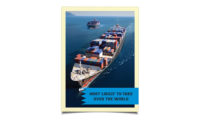The state of the export market for U.S. dairy products is mixed: It depends on the dairy product that you’re exporting and on the destination of the product.
But if I had to sum up the overall prospects for U.S. dairy exports in 2020, I would say they look good. The biggest headwinds we face are slowing global economic growth and U.S. cheese and butter prices that are well above the world market.
Milk | Cheese | Cultured | Ice Cream | Butter | Non-dairy Beverages | Ingredients | Exports
Cold dice
First, let’s talk about how 2019 is shaping up. Last year in this space, I argued that exports could still turn out decent despite the retaliatory tariffs that China and Mexico were placing on U.S. products. If you look at exports of dairy products that were not affected by retaliatory tariffs for the first seven months of this year, they were up 3.3% from last year.
The United States has continued to make headway in markets outside of China and Mexico. However, exports that were hit with retaliatory tariffs were down 53% during the first seven months of the year. That nets out to a 13.7% total decline in total exports. U.S. exports have been a little weaker than I was expecting, but they haven’t been horrible.
The impact of retaliatory tariffs is starting to fade: Mexico dropped their retaliatory tariffs on U.S. cheese in May, and China removed the retaliatory tariff on U.S. dry permeate for the next 12 months. U.S. cheese exports to Mexico are down only 11.3% year-to-date, so removing the tariffs won’t provide a big boost to exports, but any little bit helps.
The retaliatory tariffs weren’t the only thing impacting shipments of whey products to China. I estimate that about a third to a half of the decline in whey product shipments to China was due to the outbreak of African Swine Fever (ASF) and not directly related to the tariffs. So the full recovery in U.S. whey exports will be tied to the eventual stabilization and rebuilding of the Chinese hog herd.
The good news is that it appears that some farms in China are now trying to restock their barns, and Chinese whey imports were better than expected in June and July.
While the hog herd in China may be close to stabilizing, new cases of ASF are being detected in other Asian countries. China produced more than 700 million hogs in 2017. If you add together hog production across all of the other Asian countries, it totaled only 149 million in 2017.
If China’s hog herd is cut in half, it reduces total global demand for whey products by 6%. If half the herd in the remainder of Asia is slaughtered, it reduces global demand by only 1.6%. While news of ASF spreading further in Asia isn’t good for U.S. dairy exports, the impact won’t be anywhere near the impact ASF in China has had.
European exports seven out
The best prospects for stronger U.S. dairy exports (and prices) in 2020 are probably nonfat dry milk (NFDM) and skim milk powder (SMP). Europe is running out of SMP. From January through June, its SMP production was up 8,000 metric tons (MT) from the previous year, but its exports were at a record high (up 121,000 MT).
If Europe keeps up this pace, its estimated inventories will be near zero by the end of 2020. EU exports will have to slow down in 2020, and that opens opportunities for U.S. exporters.
When I worked through the balance tables for 2020, it looks like the United States — and maybe New Zealand (if whole milk powder exports to China slow) — will be the only major exporter that will be able to fill in the demand gap left by a slowdown in EU exports. By my numbers, we should be looking at a record year for U.S. NFDM/SMP exports in 2020.
With the hog herd in China likely bottoming out in late 2019 and the further spread of ASF in Asia having only a minor impact on overall whey demand, U.S. whey product exports in 2020 should improve. With the EU running out of SMP, U.S. NFDM/SMP exports should also improve.
U.S. cheese prices are well above the other major exporters in late 2019, so U.S. cheese exports are going to struggle a bit in early 2020. And U.S. butter exports are facing the same problem. But if I look at total milk-equivalent exports in 2020, I think the United States could be near a record high and up 8% from 2019. The state of the export market for U.S. dairy products is mixed, but 2020 does look brighter than 2019.
Milk | Cheese | Cultured | Ice Cream | Butter | Non-dairy Beverages | Ingredients | Exports




